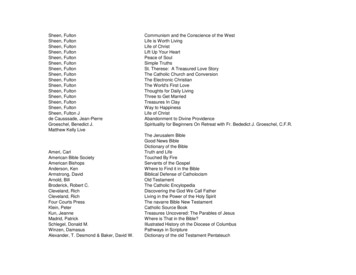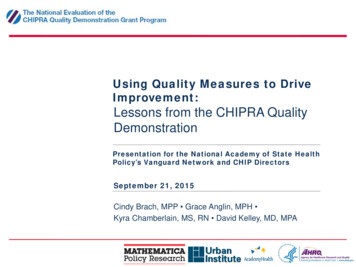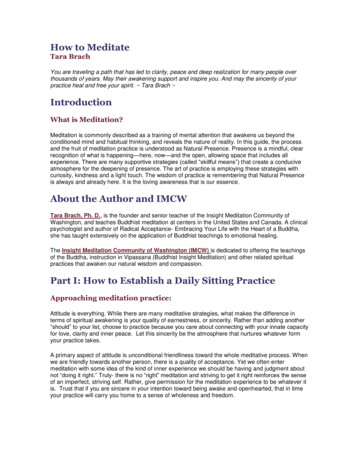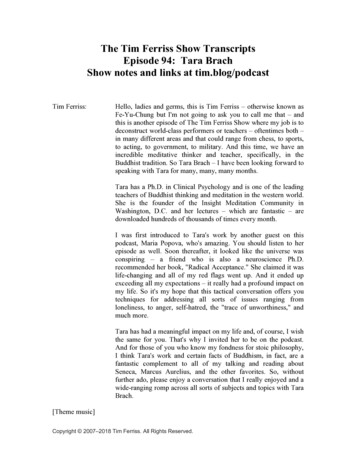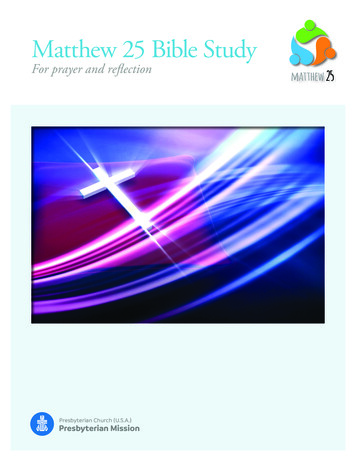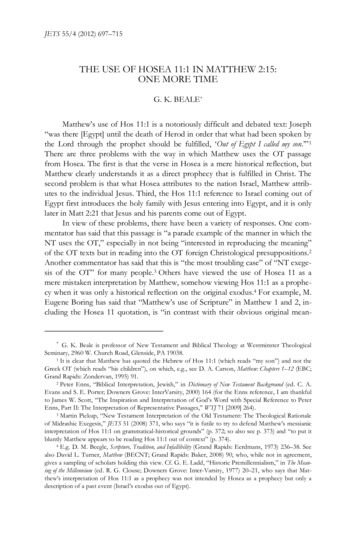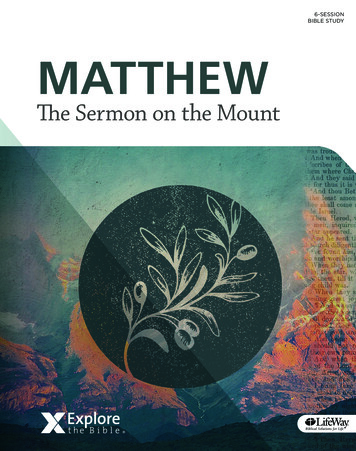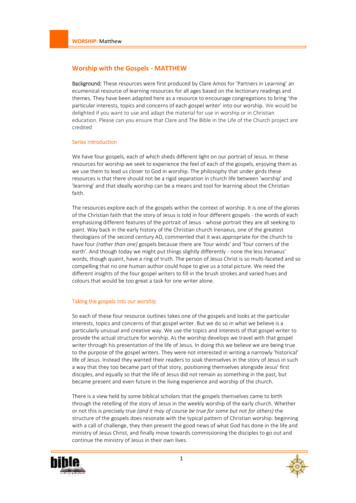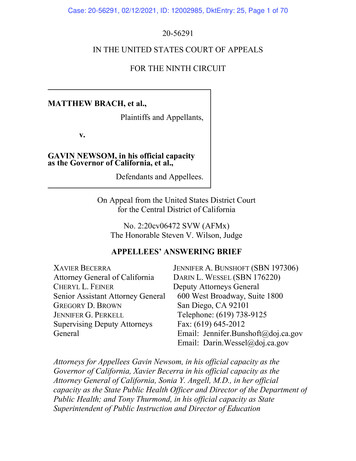
Transcription
Case: 20-56291, 02/12/2021, ID: 12002985, DktEntry: 25, Page 1 of 7020-56291IN THE UNITED STATES COURT OF APPEALSFOR THE NINTH CIRCUITMATTHEW BRACH, et al.,Plaintiffs and Appellants,v.GAVIN NEWSOM, in his official capacityas the Governor of California, et al.,Defendants and Appellees.On Appeal from the United States District Courtfor the Central District of CaliforniaNo. 2:20cv06472 SVW (AFMx)The Honorable Steven V. Wilson, JudgeAPPELLEES’ ANSWERING BRIEFXAVIER BECERRAJENNIFER A. BUNSHOFT (SBN 197306)Attorney General of CaliforniaDARIN L. WESSEL (SBN 176220)CHERYL L. FEINERDeputy Attorneys GeneralSenior Assistant Attorney General 600 West Broadway, Suite 1800San Diego, CA 92101GREGORY D. BROWNTelephone: (619) 738-9125JENNIFER G. PERKELLFax: (619) 645-2012Supervising Deputy AttorneysEmail: Jennifer.Bunshoft@doj.ca.govGeneralEmail: Darin.Wessel@doj.ca.govAttorneys for Appellees Gavin Newsom, in his official capacity as theGovernor of California, Xavier Becerra in his official capacity as theAttorney General of California, Sonia Y. Angell, M.D., in her officialcapacity as the State Public Health Officer and Director of the Department ofPublic Health; and Tony Thurmond, in his official capacity as StateSuperintendent of Public Instruction and Director of Education
Case: 20-56291, 02/12/2021, ID: 12002985, DktEntry: 25, Page 2 of 70TABLE OF CONTENTSPageIntroduction . 1Statement of Jurisdiction . 5I.COVID-19 and California’s Response to Contain ItsSpread. . 6II.The District Court Proceedings . 14A.The Complaint and Temporary Restraining OrderApplication. 14B.The District Court Grants Summary Judgment forthe State. 16Standard of Review . 17Summary of Argument . 18Argument . 21I.The State’s Public-Health Related Restrictions on InPerson Instruction in Schools Do Not Violate SubstantiveDue Process . 21A.The Orders Do Not Infringe upon AnyFundamental Rights, and thus Are ReviewedUnder the Rational Basis Test, Which They EasilySurvive . 211.There is no fundamental right to a minimumeducation under the Fourteenth Amendment . 232.There also is no “quasi-fundamental” rightto a basic minimum education . 273.The Court should reject Appellants’ requestto create a new fundamental right to aminimum education because it falls outsidezone of commonly recognized “fundamentalrights” and would violate federalismprinciples . 31i
Case: 20-56291, 02/12/2021, ID: 12002985, DktEntry: 25, Page 3 of 70TABLE OF CONTENTS(continued)4.B.C.II.Pagea.Substantive due process is a limitationon the State’s power, and generallyprotects governmental intrusion onfundamental personal rights to libertyand privacy . 33b.The importance of education does notmean that there is a fundamentalconstitutional right to a basiceducation . 34The due process right of parents to decidewhether to send their children to public orprivate school is not implicated here . 37The Orders Are Valid Because They Bear aReasonable Relation to the Compelling StateInterest in Protecting Students, Teachers, SchoolStaff, and the Public from a Rapidly SpreadingDisease . 391.The State has not only a legitimate, but alsoa compelling interest in containing andmitigating the effect of the COVID-19pandemic on education delivery . 392.The Orders bear a reasonable relationship tothe State’s interest in protecting health andsafety during the COVID-19 pandemic . 40Appellants’ Reliance on Post-Judgment Matters IsImproper and, in Any Case, Does Not Underminethe Validity of the Challenged Orders . 47The State’s Public-Health Related Restrictions on InPerson Instruction in Schools Do Not Violate EqualProtection . 50ii
Case: 20-56291, 02/12/2021, ID: 12002985, DktEntry: 25, Page 4 of 70TABLE OF CONTENTS(continued)PageA.The Orders Do Not Treat Similarly SituatedGroups Differently . 51B.Even if Schools Were Deemed Similarly Situatedto Day Care and Camps for Equal ProtectionPurposes, the Distinction Would Be ReviewedUnder the Deferential Rational Basis Standard . 53C.The Orders Are Valid Under Rational BasisReview . 57Conclusion . 58iii
Case: 20-56291, 02/12/2021, ID: 12002985, DktEntry: 25, Page 5 of 70TABLE OF AUTHORITIESPageCASESAlaska Ctr. for the Env’t v. U.S. Forest Serv.189 F.3d 851 (9th Cir. 1999) . 15Ambach v. Norwick441 U.S. 68 (1979). 35Anderson v. Liberty Lobby, Inc.477 U.S. 242 (1986). 18Angelotti Chiropractic, Inc. v. Baker791 F.3d 1075 (9th Cir. 2015) . 40, 54, 55Bd. of Nat. Res. of State of Wash. v. Brown992 F.2d 937 (9th Cir. 1993) . 27Bishop v. Smith760 F.3d 1070 (10th Cir. 2014) . 55Branch Banking & Tr. Co. v. D.M.S.I., LLC871 F.3d 751 (9th Cir. 2017) . 17Brian B. v. Com. of Pa Dept. of Educ.203 F.3d 582 (3rd Cir. 2000) . 29C.R. v. Eugene School Dist. 4J853 F.3d 1142 (9th Cir. 2016) . 21Calloway v. Dist. of Columbia216 F.3d 1 (D.C. Cir. 2000) . 29Campbell v. Washington Dep’t of Soc. & Health Servs.671 F.3d 837 (9th Cir. 2011) . 17Celotex Corp. v. Catrett477 U.S. 317 (1986). 18iv
Case: 20-56291, 02/12/2021, ID: 12002985, DktEntry: 25, Page 6 of 70TABLE OF AUTHORITIES(continued)PageCity of Cleburne v. Cleburne Living Ctr.473 U.S. 432 (1985). 52Dairy v. Bonham2013 WL 3829268 (N.D. Cal. July 23, 2013) . 56DeShaney v. Winnebago Cty. Dep’t of Soc. Serv.489 U.S. 189 (1989). 33Desoto CAB Co., Inc. v. Picker228 F. Supp. 3d 950 (N.D. Cal. 2017). 56FCC v. Beach Commc’ns, Inc.508 U.S. 307 (1993). 54, 55, 57Fields v. Palmdale Sch. Dist.427 F.3d 1197 (9th Cir. 2005) . 15, 22, 36Forest Guardians v. U.S. Forest Serv.329 F.3d 1089 (9th Cir. 2003) . 17Fowler Packing Co., Inc. v. Lanier844 F.3d 809 (9th Cir. 2016) . 23Gallinger v. Becerra898 F.3d 1012 (9th Cir. 2018) . 52Gish v. NewsomNo. EDCV20-755-JGB, 2020 WL 1979970 (C.D. Cal. Apr.23, 2020) .7Guadalupe Org., Inc. v. Tempe Elementary Sch. Dist. No. 3587 F.2d 1022 (9th Cir. 1978) . 27Halverson v. Skagit Cnty42 F.3d 1257 (9th Cir. 1994) . 22, 23, 32v
Case: 20-56291, 02/12/2021, ID: 12002985, DktEntry: 25, Page 7 of 70TABLE OF AUTHORITIES(continued)PageHarkins Amusement Enterprises, Inc. v. General Cinema Corp.850 F.2d 477 (9th Cir. 1988) . 48Horne v. Flores557 U.S. 433 (2009). 47Kadrmas v. Dickinson Pub. Sch.487 U.S. 450 (1988). passimKansas v. Hendricks521 U.S. 346 (1997). 39Kawaoka v. City of Arroyo Grande17 F.3d 1227 (9th Cir. 1994) . 23Klinger v. Dep’t of Corr.31 F.3d 727 (8th Cir. 1994) . 52Lippi v. City Bank955 F.2d 599 (9th Cir. 1992) . 48Litmon v. Harris768 F.3d 1237 (9th Cir. 2014) . 22Lowry v. Barnhart329 F.3d 1019 (9th Cir. 2003) . 48Marshall v. United States414 U.S. 417 (1974). 46, 47Meyer v. Nebraska262 U.S. 390 (1923). 38Nissho-Iwai American Corp. v. Kline845 F.2d 1300 (5th Cir. 1988) . 48vi
Case: 20-56291, 02/12/2021, ID: 12002985, DktEntry: 25, Page 8 of 70TABLE OF AUTHORITIES(continued)PageNordlinger v. Hahn505 U.S. 1 (1992). 54Obergefell v. Hodges576 U.S. 644 (2015). 24, 34Papasan v. Allain478 U.S. 265 (1986). 24, 26, 29, 54Payne v. Peninsula Sch. Dist.653 F.3d 863 (9th Cir. 2011) . 27Pierce v. Soc’y of the Sisters of the Holy Names of Jesus &Mary268 U.S. 510 (1925). 38Plyler v. Doe457 U.S. 202 (1991). passimRaich v. Gonzales500 F.3d 850 (9th Cir. 2007) . 37Reno v. Flores507 U.S. 292 (1993). 22Roman Cath. Diocese of Brooklyn v. Cuomo-- U.S. -- (2020) . 20, 31, 39, 46RUI One Corp. v. City of Berkeley371 F.3d 1137 (9th Cir. 2004) . 54S. Bay United Pentecostal Church v Newsom591 U.S. (2020) (South Bay III) . 6, 39San Antonio Ind. Sch. Dist. v. Rodriguez411 U.S. 1 (1973). passimvii
Case: 20-56291, 02/12/2021, ID: 12002985, DktEntry: 25, Page 9 of 70TABLE OF AUTHORITIES(continued)PageThornton v. City of St. Helens425 F.3d 1158 (9th Cir. 2005) . 51, 53U.S. v. Harding971 F.2d 410 (9th Cir. 1992) . 29United States v. Lopez514 U.S. 549 (1995). 36, 47United States v. Navarro800 F.3d 1104 (9th Cir. 2015) . 46United States v. Pickard100 F. Supp. 3d 981 (E.D. Cal. 2015) . 56United States v. Wilde74 F. Supp. 3d 1092 (N.D. Cal. 2014). 56Vernon v. City of Los Angeles27 F.3d 1385 (9th Cir. 1994) . 36Washington v. Glucksberg521 U.S. 702 (1997). 22, 32, 33, 39Whitlow v. California203 F.Supp.3d. 1079 (S.D. Cal. 2016) . 27Wisconsin v. Yoder406 U.S. 205 (1972). 37, 38STATUTESUnited States Code, Title 28§ 129 .5§ 1331 .5§ 1343 .5viii
Case: 20-56291, 02/12/2021, ID: 12002985, DktEntry: 25, Page 10 of 70TABLE OF AUTHORITIES(continued)PageCalifornia Edudcation Code§ 43500 . 31§ 43503 . 4, 31§ 43504 . 4, 31FEDERAL RULESFederal Rule of Civil Procedure 56 . 17REGULATIONSCalifornia Code of RegulationsTitle 5, § 18290 . 53Title 22, § 101216.3 . 53Title 22, § 102416.5 . 53ix
Case: 20-56291, 02/12/2021, ID: 12002985, DktEntry: 25, Page 11 of 70INTRODUCTIONGovernor Gavin Newsom and State officials have adopted appropriatepublic health orders and guidance using science and data-driven approachesin their efforts to protect Californians during the unprecedented, deadlyCOVID-19 pandemic. In response to the rapid and deadly spread ofCOVID-19, Governor Newsom proclaimed a State of Emergency on March4, 2020, and, on March 19, 2020, issued an executive order directing allCalifornians to heed State public-health directives. 1-SER-35-39, 41-45.The State Public Health Officer likewise issued a March 19, 2020 orderdirecting Californians to stay at home, with various exceptions to access orsupport the operation of critical services. 1-SER-85. Since that time,additional orders and guidance have been issued in an effort to limit diseasespread, protect the health of vulnerable populations, and mitigate the risks ofoverwhelming our healthcare system, all while balancing safely reopeningsectors of society as warranted by the evolving science.By this case, Appellants challenged orders and guidance related toeducation for grades kindergarten through 12 (including transitionalkindergarten, hereinafter “TK-12”) and restrictions on reopening schools toin-person instruction. Specifically, Appellants challenged the July 17, 2020COVID-19 and Reopening In-Person Learning Framework for K-12 Schools1
Case: 20-56291, 02/12/2021, ID: 12002985, DktEntry: 25, Page 12 of 70in California, 2020-2021 School Year (the July 17th Order) that temporarilydelays re-opening of schools for in-person instruction in counties on theState’s Monitoring List1 due to high rates of communitywide COVID-19transmission. 1-SER-98-102. The challenged Order was issued at a timewhen COVID-19 transmission rates had significantly increased and shortlyafter the Public Health Officer had issued new orders to help mitigate thespread of COVID-19. See 1-SER-7-96.As this case progressed, additional orders and updated guidance wereissued by the California Department of Public Health (CDPH) to addressschools and in-person instruction. This included the “Elementary Waiver”process, guidance that allowed schools serving grades TransitionalKindergarten through 6 (TK-6) to apply for a waiver that would permit themto offer in-person instruction even if the schools were in counties on theWhile the matter was still pending below, the State replaced theMonitoring List with a four-tiered system, known as the Blueprint for aSafer Economy, that placed each county in a particular tier based on itsadjusted COVID-19 rates and positivity rates, and tied restrictions onspecified settings or sectors to factors known to increase the risk oftransmission of COVID-19. For schools, the Blueprint did not materiallyaffect the July 17th Order, as the restrictions applicable when a county wason the former Monitoring List applied for any county in the tier reflectingthe highest rate of transmission (Tier 1/Purple Tier) and the metrics andthresholds used for the Monitoring List were roughly equivalent to themetrics and thresholds for the Tier 1.12
Case: 20-56291, 02/12/2021, ID: 12002985, DktEntry: 25, Page 13 of 70Monitoring List (subsequently updated to reference Tier 1), the level ofhighest transmission, under the Blueprint for a Safer Economy, see n.1supra), based on scientific evidence establishing the relatively lower risk oftransmission among young children. 1-SER-131-142. It also includedCDPH’s Cohort Guidance, which allows schools that are not permitted toreopen for in-person instruction to offer in-person supervision, services andinstruction to children in small stable cohorts, especially for those with thehighest needs or who may be particularly struggling with distance learning,as long as specified guidelines are followed to minimize the total number ofindividuals who may be exposed if a member of the cohort contractsCOVID-19. 3-SER-606, 610-614. (Collectively, the Orders.)Taken together, the Orders: (1) generally prohibit schools fromreopening for in-person instruction in counties with high rates of COVID-19transmission; (2) authorize county public-health officers to grant waivers topermit schools serving grades TK to 6 to reopen in counties where schoolsare not permitted to reopen under (1) by satisfying certain specifiedrequirements; and (3) authorize all schools, including those not permitted toreopen under (1) and (2), to provide in-person services and instruction tosmall groups of students in stable cohorts. And they operate against thebackground of state law in effect for the 2020-21 school year specifying3
Case: 20-56291, 02/12/2021, ID: 12002985, DktEntry: 25, Page 14 of 70requirements for distance learning that schools must offer if they are notopen for in-person instruction. Cal. Educ. Code §§ 43503, 43504.Over the course of the ongoing State of Emergency, the Governor andstate health officials have modified the Orders and guidance governingschools in response to the most up-to-date public-health knowledge andscientific consensus, and while considering local input and decision-makingin key areas to the extent feasible. The State also implemented measuresand allocated billions of dollars through the state budget to support studentsreceiving distance education during this trying pandemic.Appellants, parents of school-aged children and one student, sought anorder enjoining enforcement of the Orders, on the grounds that theyallegedly violated their constitutional rights by depriving their children ofthe option of receiving in-person education. Appellants challenge thedistrict court’s grant of summary judgment for Appellees on theirsubstantive due process and equal protection claims under the FourteenthAmendment. Because Appellants fail to establish any legally viable basis toenjoin the appropriate and necessary measures undertaken by the State toprotect the lives and health of students, teachers, staff, and the public, thegrant of summary judgment should be affirmed.4
Case: 20-56291, 02/12/2021, ID: 12002985, DktEntry: 25, Page 15 of 70The State in no way discounts the significant challenges and burdensthat school closures and distance learning represent for students, families,and school employees. Everyone would prefer that the country not be in themidst of an unprecedented public-health crisis. But it is. And based on thevirulence and deadliness of COVID-19, which has killed more than 46,000Californians to date,2 until there are significant levels of vaccination or therisks of transmission are otherwise abated, schools simply cannot operate asnormal in communities with high rates of community transmission withoutimperiling public health.STATEMENT OF JURISDICTIONThe district court had jurisdiction over Appellants’ civil rights claimsunder 28 U.S.C. §§ 1331, 1343. The district court entered a final order onDecember 1, 2020, granting summary judgment in favor of Defendants. 1ER-22. Appellants filed a timely notice of appeal on December 3, 2020. 3ER-553. This Court has jurisdiction over the appeal under 28 U.S.C. § s/Immunization/ncov2019.aspx.25
Case: 20-56291, 02/12/2021, ID: 12002985, DktEntry: 25, Page 16 of 70ISSUES PRESENTEDThis appeal presents the following issues:1.Whether the State’s public-health related policies governing in-person instruction in schools violate substantive due process under theFourteenth Amendment; and2.Whether the State’s public-health related policies governing in-person instruction in schools violate the Equal Protection clause of theFourteenth Amendment.STATEMENT OF THE CASEI.COVID-19 AND CALIFORNIA’S RESPONSE TO CONTAIN ITSSPREAD.COVID-19 is a highly contagious and potentially deadly infectiousdisease, which can be readily transmitted when people gather in groupsindoors. 1-SER-7-8. The novel coronavirus that causes COVID-19 spreadsthrough respiratory or aerosol droplets that remain in the air, and may betransmitted unknowingly by individuals who exhibit no symptoms. 1-SER5; S. Bay United Pentecostal Church v Newsom, 591 U.S. , 140 S. Ct.1613, 1613-14 (2020) (Roberts, CJ, concurring) (South Bay III). At theoutset of the pandemic, there was no known cure, no widely effectivetreatment, and no vaccine. 1-SER-5. Consequently, measures such as6
Case: 20-56291, 02/12/2021, ID: 12002985, DktEntry: 25, Page 17 of 70physical distancing that limit in-person contact are widely recognized as acritical tool for effectively slowing the spread. Gish v. Newsom, No.EDCV20-755-JGB (KKx), 2020 WL 1979970, at *4 (C.D. Cal. Apr. 23,2020); 1-SER-6.California responded early to combat and contain the COVID-19 threat.In early December 2019—before the virus was known to have entered theUnited States, the State began working closely with the national Centers forDisease Control and Prevention, the United States Health and HumanServices Agency, and local health departments to monitor and plan for thespread of COVID-19 to the United States. 1-SER-35-39. At that time, theCalifornia Department of Public Health (CDPH) began providing COVID19 related guidance to hospitals, clinics, and other health providers. Id.On March 4, 2020, the Governor proclaimed a State of Emergency inCalifornia, making available additional resources to combat the emergencyand help the State prepare to address the broader spread of the disease. 1SER-35-39. On March 19, the Governor issued Executive Order N-33-20,the Stay-at-Home Order, which required “all individuals living in the Stateof California to stay home or at their place of residence except as needed tomaintain continuity of operations of the federal critical infrastructure7
Case: 20-56291, 02/12/2021, ID: 12002985, DktEntry: 25, Page 18 of 70sectors.” The Public Health Officer subsequently designated a list of“Essential Critical Infrastructure Workers” under the Order. 1-SER-47-60.On April 28, 2020, the Governor announced a “Resilience Roadmap”to guide the gradual and safe reopening of the State. 1-SER-62-75. TheRoadmap was based on four stages: (1) safety and preparation; (2) reopeningof lower-risk workplaces and other spaces; (3) reopening of higher-riskworkplaces and other spaces; and (4) an end to the Stay-at-Home Order. 1SER-66. To implement the Roadmap, on May 4, 2020, the Governor issuedExecutive Order N-60-20, providing that all California residents were tocontinue complying with the Stay-at-Home Order, and directing that theState Public Health Officer establish criteria and procedures for qualifyinglocal jurisdictions to move more quickly through Stage 2 of the Roadmap. 1SER-78-79.On May 7, 2020, based on her review of current data, the then StatePublic Health Officer, Sonia Y. Angell, issued an order transitioningCalifornia into Stage Two, stating that she would “progressively designatesectors, businesses, establishments, or activities that may reopen with certainmodifications, based on public health and safety needs” and at “a pacedesigned to protect public health and safety.” 1-SER-82. Guidancegoverning the reopening of in-person instruction at schools as part of Stage 28
Case: 20-56291, 02/12/2021, ID: 12002985, DktEntry: 25, Page 19 of 70was initially released on June 5, 2020, with other sectors scheduled toreopen in phases throughout the month of June. See 1-SER-69.In response to a surge in COVID-19 cases in late June to early July,2020, the State Public Health Officer, on July 13, 2020, issued an orderclosing, statewide, certain activities that had previously been permitted toreopen under the Roadmap, and closing additional indoor activities in thosecounties on the State’s County Monitoring List. 1-SER-87-90. The PublicHealth Officer noted that, particularly in counties on the County MonitoringList, “the risks and impacts of disease transmission are even greater.” 1SER-88.3 She further explained that:The science suggests that for indoor operations the oddsof an infected person transmitting the virus aredramatically higher compared to an open-airenvironment. Thus, for those counties on the list, it isnecessary to close indoor operations for additionalsectors which promote closed-space mixing ofpopulations beyond households and/or make adherenceto physical distancing with face coverings difficult.At that time, CDPH used six indicators to track the level of COVID19 infection in each California county, as well as the preparedness of thecounty health care system—data that includes the number of new infectionsper 100,000 residents, the test positivity rate, and the change inhospitalization rate, among others. A county that did not meet the State’sbenchmarks was put on the County Monitoring List. 1-SER-153-155, 157158.39
Case: 20-56291, 02/12/2021, ID: 12002985, DktEntry: 25, Page 20 of 701-SER-88, 95-96.On July 17, 2020, CDPH issued its COVID-19 and Reopening InPerson Learning Framework for K-12 Schools in California, 2020-2021School Year. 1-SER-98-102; 2-SER-386. It updated its previously issuedSchool Sector Specific Guidelines to specify that “[s]chools and schooldistricts may reopen for in-person instruction at any time if they arelocated in a local health jurisdiction (LHJ) that has not been on thecounty monitoring list within the prior 14 days.” 1-SER-98 (emphasis inoriginal). The guidance explained that a waiver of the criteria “may begranted by the local health officer for elementary schools to open for inperson instruction,” and that additional details about the waiver process wereforthcoming. Id.On August 3, 2020, CDPH updated its guidance to schools. 1-SER104-123. It also issued an FAQ and additional documents to provideguidance to schools that wanted to seek a waiver. 1-SER-125-148. ThisElementary Waiver Guidance allowed elementary schools in counties on theState’s former Monitoring List, now Tier 1, to apply to their local healthofficer for a waiver that would allow them to reopen with in-personinstruction. Id. The materials explained that, “[b]ased on the current bestavailable scientific evidence, COVID-related risks in schools serving10
Case: 20-56291, 02/12/2021, ID: 12002985, DktEntry: 25, Page 21 of 70elementary-age students (grades TK-6) are lower than and different from therisks to staff and to students in schools serving older students.” 1-SER-128.Specifically, they noted that, “there appears to be lower risk of child-to-childor child-to-adult transmission in children under age 12,” and a lower risk ofinfection and serious illness in younger children. 1-SER-31, 128, 131.There was growing consensus when the July 17th Order andElementary Waiver Guidance were adopted that: children are, indeed,susceptible to COVID-19 infection and transmission; some children infectedwith COVID-19 experience serious complications like multisysteminflammatory syndrome; the available data might not accurately reflectactual infection rates among children; and studies on transmission betweenchildren and adults were sparse. 1-SER-9, 11, 131-133; 2-SER-253-255,257-262, 264-269, 277-278, 280-282. Reopening all schools to in-personinstruction, even those i
San Diego, CA 92101 Telephone: (619) 738-9125 Fax: (619) 645-2012 Email: Jennifer.Bunshoft@doj.ca.gov Email: Darin.Wessel@doj.ca.gov Attorneys for Appellees Gavin Newsom, in his official capacity as the Governor of California, Xavier Becerra in his official capacity as the Attorney General of California, Sonia Y. Angell, M.D., in her official

